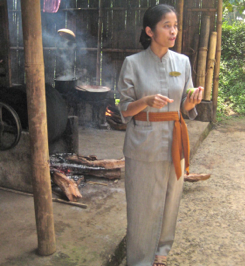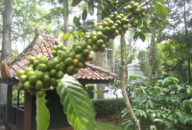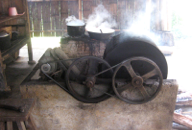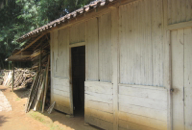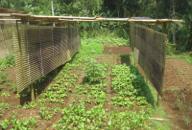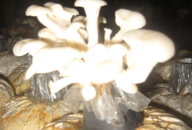plantation tour
Losari Coffee Plantation resort & spa
Megelang highlands, central java, indonesia
april 15, 2009


plantation tour
Losari Coffee Plantation resort & spa
Megelang highlands, central java, indonesia
april 15, 2009




Each morning at 10 AM, Sonia, or another member of the hotel staff, guides guests through the coffee plantation on a walking tour. On Wednesday, we walked along the neatly tended paths, some lined with clipped hedges, to see the shiny green leaves and thick round berries of the coffee trees. These plants, preferring semi-tropical conditions for their cultivation, grow best in shaded conditions. Thus, the plantation is shaded by a canopy of tall trees and bamboo, beautiful and pleasant to be amongst. We saw new growth grafted onto older trees, utilizing the stability and deep roots of the established ones. Stems of the young seedlings are inserted into a small split branch of the older tree, the two tied together. A tiny clear plastic bag protects the graft from insects and water for a few weeks, until the graft is complete. The coffee trees come into flower in October and November, with the berries ripening between July and September. Harvest, done carefully by hand, occurs over a three month period, as the berries ripen gradually, dependent on the sun. After the beans are picked, the outer red or yellow skins are peeled off. The coffee beans are then dried and stored for at least one year, and often for two years or more before they are roasted. The longer the beans are stored, the lower the acid content, so the coffee is richer and finer. The beans are then roasted in small batches in what is considered an “automatic roaster”, the iron drum of which is turned by a gear and wheel over a wood fire, a process which requires two hours. After roasting, the hard outer shell is removed from the coffee beans and the beans are then ready to be ground and packaged for sale. All the coffee produced on the Losari Coffee Plantation is used at the resort, some of which is packaged to be sold in the gift shop. After Sonia lead us through the plantation explaining the cycle of growth of coffee trees, the harvest, and the processing of the coffee beans, we were treated to a coffee tasting of traditional Javanese coffee; and, we were introduced to the traditional Javanese Jamu, boiled herbal elixers for health and healing. She then showed us the organic mushroom farm. This was located in a wooden building, where orderly shelves held the elements for germinating mushrooms. Plastic bottles, made from flat, light plastic sheeting, were stuffed with sawdust and a growth medium, enabling these light forms to stand upright. These containers were then sealed with a bit of natural cotton that was stuffed into a bottle neck of hard black plastic. These mediums for cultivation are watered daily, while the wood inside them provides the natural spores to germinate the mushrooms. I was very impressed to see such innovation. We were also shown the organic gardens which produce vegetables and lettuce for use on the plantation. Walking back toward the Club House, we passed fruit trees, including Durian fruit trees laden with ripening fruit. The tour offered us an impressive look at the making of “java” on Java, and gave us a deeper appreciation for each cup of coffee we drink.
PHOTOS: Left Column: 1. Coffee tree with a new graft. The small plastic bag protects the graft from insects and water. 2. Sonia, our guide, with a ripe coffee bean in her hand. 3. A large flat iron pan containing sap, being boiled down to palm sugar over the wood stove. 4. The coffee processing buildings in the Traditional Javanese Joglo style of tile roofs. 5. Bamboo trellises and flats of vegetable seedlings. A new lettuce garden is in the foreground. 6. The building which contains the organic mushroom cultivation shelves. Center, Top: Sonia, our guide, explaining the process of grafting as she stoops beneath a coffee tree. Center, Middle: Sonia, our guide, explaining the processing of coffee beans. Center, Bottom: A cultivated organic mushroom grown in sawdust and a growth medium. Right Column: 1. The branch of a coffee tree bearing shiny leaves and large coffee beans. 2. A branch with unripe coffee beans. A traditional Javanese Joglo roof is on the building in the background. 3. A manicured walkway through the plantation gardens. 4. An “automatic” cast iron roasting machine with a wood fire built beneath it. 5. Bamboo framing an organic lettuce garden on the property. Guests can pick their own lettuce for their salads which are prepared at the Red Jade Restaurant. 6. New mushroom growth in the organic mushroom cultivation shed.

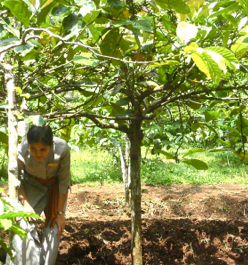
IN PARTNERSHIP WITH NATURE

